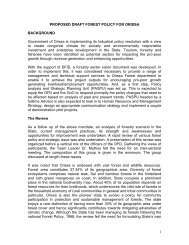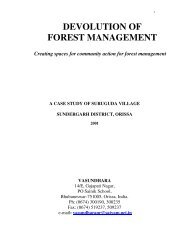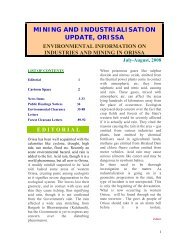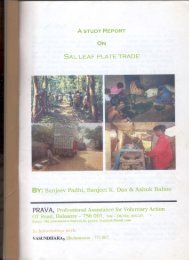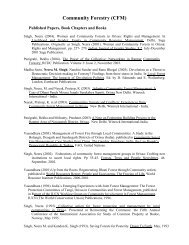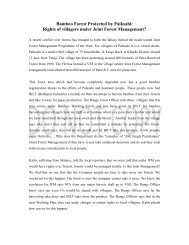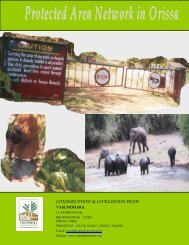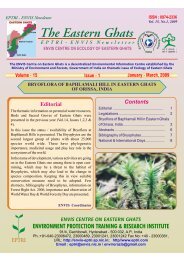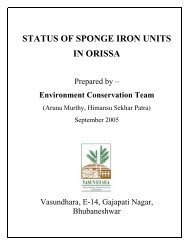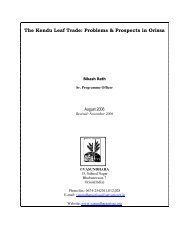Bamboo in Orissa: Trade and Livelihood Perspective - Vasundhara
Bamboo in Orissa: Trade and Livelihood Perspective - Vasundhara
Bamboo in Orissa: Trade and Livelihood Perspective - Vasundhara
You also want an ePaper? Increase the reach of your titles
YUMPU automatically turns print PDFs into web optimized ePapers that Google loves.
All rights reserved by VASUNDHARA(www.vasundharaorissa.org). For any clarification, contact author at sunlit1968@yahoo.co.<strong>in</strong><br />
bamboo plantation was created under the FDA scheme dur<strong>in</strong>g 2003-04. Similarly, under<br />
RLTAP the area of such plantations was 1000 hectare <strong>and</strong> 855 hectare dur<strong>in</strong>g 2003-04 <strong>and</strong><br />
2004-05 respectively(per comm.., Deputy Conservator of Forest, Social Forestry &<br />
Afforestation)..<br />
Such plantations have been planned even for areas hav<strong>in</strong>g little or no bamboo<br />
forests(natural), but technically there are certa<strong>in</strong> limitations which the silviculturists have<br />
to consider. Pure bamboo forests are usually open forests <strong>and</strong> they do not normally allow<br />
other plant species to grow with them. Hence, unless the area is to be exclusively selected<br />
for pure bamboo plantation, precautions should be taken so that bamboo does not take over<br />
all other species <strong>in</strong> the mixed plantations. In mixed plantations, bamboo is to be ma<strong>in</strong>ta<strong>in</strong>ed<br />
as an undergrowth <strong>and</strong> this is possible if bamboo is planted <strong>in</strong> the 2 nd or 3 rd year of the<br />
plantation (per comm.., DCF, Social Forestry & Afforestation).<br />
Normally the species planted is salia. Either seedl<strong>in</strong>gs are used or propagules prepared<br />
from rhizomes.<br />
Significance <strong>in</strong> the livelihood of the poor:<br />
While around 55 lakh people <strong>in</strong> the state reportedly depend partially on bamboo for their<br />
livelihood(Mohanty D. 2004, op.cit.), some like bamboo cutters <strong>and</strong> artisans chiefly<br />
depend on this resource <strong>in</strong> one way or another whose total number may be between 1 lakh<br />
to 2 lakh, <strong>and</strong> <strong>in</strong> terms of family members, around 4 to 6 lakhs. Follow<strong>in</strong>g is an account of<br />
the significance of bamboo <strong>in</strong> the livelihood of these people:<br />
1. Cutters:<br />
‘The exact number of bamboo cutters have never been assessed, thanks to govt apathy’,<br />
says D<strong>and</strong>apani Mohanty, a leader of bamboo-cutters union. He however presents his own<br />
assessment on the basis of the fact that there were 325 bamboo coupes <strong>in</strong> <strong>Orissa</strong> <strong>and</strong> <strong>in</strong><br />
each coupe worked 200 to 300 labourers which <strong>in</strong>cluded mostly cutters, <strong>and</strong> hence taken<br />
the average number to be 200 labourers per coupe, the total figure would be 65000(per<br />
comm..). However, this estimation is unreliable s<strong>in</strong>ce all the coupes are not worked<br />
simultaneously; rather <strong>in</strong> the 4-year fell<strong>in</strong>g cycle about 25% of the coupes are worked <strong>in</strong> a<br />
year. Further, Mohanty's figure also <strong>in</strong>cludes secondary labourers(like those engaged <strong>in</strong><br />
road work, etc.) though he says that many of the secondary labourers also worked as<br />
cutters (because, <strong>in</strong>frastructure development like road work ideally precedes harvest<strong>in</strong>g<br />
operations).<br />
Ramach<strong>and</strong>ra Bakshipatra, another union leader, f<strong>in</strong>ds it safe to put the figure(of cutters) at<br />
maximum 45000. Accord<strong>in</strong>g to him, about 26000 cutters are expected to work under JK<br />
Paper as per the present distribution of forest divisions(<strong>in</strong>clud<strong>in</strong>g those allotted earlier to<br />
Orient Paper Mills)<br />
As evident from the follow<strong>in</strong>g table, the statistics available (particularly <strong>in</strong> the newspapers)<br />
<strong>in</strong> this regard appear to be controversial because the table shows the number of cutters<br />
would exceed 1 lakh(atleast).<br />
51



